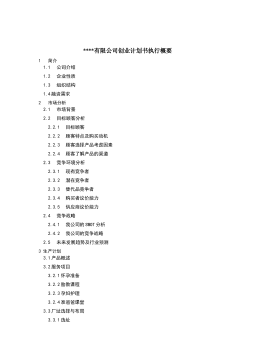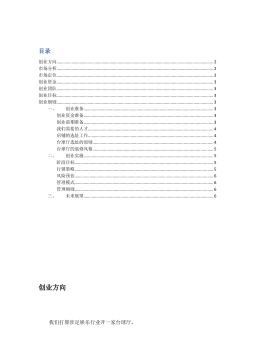USST_Arts_112040593供应链中的小微企业信用风险评价研究——基于应收账款质押贷款模式
VIP免费
摘 要
近年来,一些银行借助客户供应链中物流、信息流和资金流运行特点,突破
传统信贷思路,创造性地推出了供应链金融模式,并率先向大型企业上下游的小
微企业客户群进行推广。该模式突破了传统信贷业务的评级授信、抵押担保、审
批流程等诸多方面的限制,进行了服务方式创新,对支持小微企业发展、拓展商
业银行发展空间具有重要意义。但供应链金融在我国快速发展的同时,我们也必
须清醒的认识到这种新型融资模式涉及链条环节长、参与主体众多、操作程序复
杂,而且各个环节之间环环相扣、彼此依赖的特征决定了供应链金融业务的风险
形态和风险管理方式有别于传统的信贷模式。
本文基于商业银行的视角,以供应链中的小微企业应收账款质押融资模式为
例,对其信用风险评价指标体系进行研究。首先,在对供应链中的小微企业应收
账款质押融资模式涉及到的相关概念、信用风险的相关理论方法进行介绍的基础
上,深入分析了该模式下信用风险的成因,建立了全面合理的供应链中的小微企
业应收账款质押融资信用风险评价指标体系。为确保该指标体系的科学性和可靠
性,本文运用 SPSS 软件对评价指标相关性进行分析,对相关性较高的评价指标进行
选择性剔除。然后重点应用层次分析法和模糊综合评判理论建立了供应链中的小
微企业应收账款质押融资信用风险评价模型。最后,运用具体案例对此模型进行
验证,从而实现理论和实际的有效结合。
本文的研究对于商业银行建立专属供应链中的小微企业应收账款质押融资信
用风险评价系统具有一定的参考价值。但由于当前我国小微企业财务信息、信用
信息以及供应链的运营信息积累的有限性和隐蔽性,本文所建模型的有效性有待
进行进一步的检验和修正。
关键字:层次分析法 模糊综合评判模型 供应链中的小微企业 应收账
款质押
ABSTRACT
Recent years, a number of banks break through the traditional credit model by
means of the customer in the supply chain logistics and information flow and capital
flow operating characteristics. They creatively launched a supply chain finance model,
and firstly generalized it to small and micro enterprise customer base, which located
upstream and downstream of the core business. The model breaks through restrictions in
many aspects and conducted services innovation, such as the approval process, the
traditional credit business credit rating. This financing model has important significance
for the development of small and micro enterprises to support and to expand space for
development of commercial banks.
But at the rapid development of supply chain finance, we also must be a clear
understanding that this new financing model involves a long chain of links, many
involved in the body, the procedure complex and interlocking between the every sectors,
depend on each other. These characteristics determine the supply chain finance business
risk profile and risk management approach differs from traditional credit model.
Based on the perspective of commercial banks, the main research is the credit risk
assessment system for small and micro enterprises in this paper, maked the pledge
accounts receivable financing models as example, we studied its credit risk assessment
system. After a brief introduction to the supply chain of small and micro enterprises
pledge of accounts receivable financing models related to the concepts, theories of
Credit Risk, this paper gave a depth analysis of the causes of the credit risk and
established a comprehensive and rational credit risk evaluation index system of this
mode. To ensure the reliability of the scientific and index system, the paper selective
excluded higher correlation indicators according to make evaluation correlation analysis
by means of SPSS software. Then mainly application of the analytic hierarchy process
and fuzzy comprehensive evaluation theory, the author created a credit risk assessment
mode,. Finally, in order to achieve effective integration of theory and practice , this
model was validated using specific case.
However, due to the small and micro enterprises financial information, credit
information, supply chain operational information are limited and concealment under
China's current economic environment, effectiveness of the model needs to be carried
out further tests and fixes.
Key Words: AHP method, fuzzy comprehensive decision model, small
and micro enterprises in supply chain, receivables pledge
目 录
摘 要
ABSTRACT
第一章 导 论 .............................................................................................................. 1
1.1 研究的背景 ........................................................................................................ 1
1.2 研究意义 ............................................................................................................ 2
1.2 文献综述 ............................................................................................................ 3
1.2.1 国外研究现状以及趋势 ............................................................................. 3
1.2.2 国内研究现状以及趋势 ............................................................................. 5
1.2.3 现有研究得到的启示 ................................................................................ 11
1.3 本文研究方法 .................................................................................................. 12
1.4 研究框架和主要内容 ...................................................................................... 12
1.5 本文的创新点和不足 ...................................................................................... 14
第二章 相关理论与方法概述 .................................................................................. 16
2.1 相关概念界定 .................................................................................................. 16
2.1.1 供应链、供应链金融的含义 ................................................................... 16
2.1.2 供应链金融模式下小微企业的界定 ....................................................... 18
2.1.3 供应链中的小微企业应收账款质押融资概念 ....................................... 18
2.2 供应链金融对解决小微企业融资困境的意义 .............................................. 19
2.2.1 供应链金融的特点 ................................................................................... 19
2.2.2 供应链金融对解决小微企业融资问题的意义 ....................................... 20
2.3 供应链应收账款质押融资在我国的发展情况 .............................................. 21
2.3.1 供应链小微应收账款融资模式的现实性 ............................................... 21
2.3.2 供应链应收账款质押融资在我国的发展情况 ....................................... 22
2.4 信用风险 .......................................................................................................... 24
2.4.1 信用风险的含义 ....................................................................................... 24
2.4.2 信用风险度量的方法 ............................................................................... 24
2.5 本文所采用的信用风险评价模型简要介绍 .................................................. 28
2.5.1 层次分析法的基本原理和过程 ............................................................... 28
2.5.2 模糊综合评价模型的基本原理和过程 ................................................... 29
第三章 信用风险水平评价指标体系的构建 .......................................................... 32
3.1 信用风险产生的原因 ...................................................................................... 32
3.1.1 供应链外部环境的不确定性导致的系统性风险 ................................... 32
3.1.2 供应链应收账款融资模式的复杂性引发的多重信息不对称 ............... 32
3.1.3 应收账款质押的监管难度 ....................................................................... 33
3.2 信用风险指标体系的原则 .............................................................................. 33
3.3 供应链中的小微企业应收账款模式下信用评价指标筛选 .......................... 36
3.3.1 供应链中的小微企业信用风险指标筛选的方法 ................................... 36
3.3.2 确定信用评价体系的初选指标 ............................................................... 36
3.4 确立信用风险评价指标体系 .......................................................................... 39
3.4.1 信用风险评价指标体系的首次筛选 ....................................................... 39
3.4.2 信用风险评价指标体系的二次筛选 ....................................................... 39
3.4.3 信用风险评价指标体系的构成 ............................................................... 42
第四章 供应链中的小微企业应收账款模式下信用风险模型的建立 .................. 45
4.1 层次分析法确立指标权重的步骤 .................................................................. 45
4.2.本文确定信用风险指标权重的方法 .............................................................. 47
4.3 指标层权重的确立 .......................................................................................... 48
4.3.1 一级指标层权重的确立 ........................................................................... 48
4.3.2 外在宏观环境 A权重的确立 .................................................................. 49
4.3.3 申请企业自身状况 B权重的确立 .......................................................... 50
4.3.4 融资项下的资产状况 C权重的确立 ...................................................... 54
4.3.5 核心企业的情况 D权重的确立 .............................................................. 55
4.3.6 供应链的整体情况 E权重的确立 ........................................................... 56
4.4 各层次权重结果分析 ...................................................................................... 58
4.5 建立供应链中的小微企业信用风险水平的模糊综合评价模型 .................. 59
第五章 实证分析 ...................................................................................................... 64
5.1 案例介绍 .......................................................................................................... 64
5.2 建立该小微企业的模糊判断矩阵 .................................................................. 67
5.2.1.三级指标的模糊判断矩阵的确定 ........................................................... 67
5.2.2.二级指标判断矩阵的确定 ....................................................................... 69
5.2.3 一级模糊评价矩阵的确定 ....................................................................... 69
5.3 不考虑供应链的情况下该小企业的信用风险评价 ...................................... 70
5.4 当核心企业和供应链整体情况恶化时风险的变化情况 .............................. 70
5.5 模型的改进 ...................................................................................................... 72
5.6 结果分析 .......................................................................................................... 75
第六章 总结和展望 .................................................................................................. 76
6.1 本文总结 .......................................................................................................... 76
6.2 模型存在的问题和进一步改进方向 .............................................................. 76
6.3 政策建议 .......................................................................................................... 77
附 录 ........................................................................................................................ 79
参考文献 .................................................................................................................... 93
在读期间公开发表的论文 ........................................................................................ 98
致 谢 ........................................................................................................................ 99
相关推荐
-
我国基层财政困难的制度成因分析与对策研究VIP免费
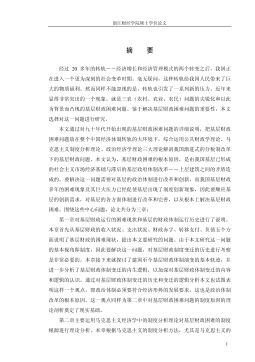
 2024-09-20 33
2024-09-20 33 -
我国煤电产业链纵向交易合约机制研究VIP免费
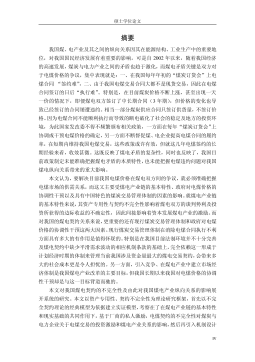
 2024-09-20 28
2024-09-20 28 -
生产要素视角下的上海市产业结构优化研究VIP免费
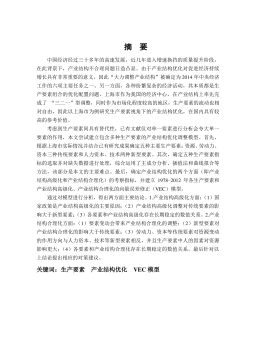
 2025-01-09 7
2025-01-09 7 -
我国银行业结构与经济结构关系研究VIP免费
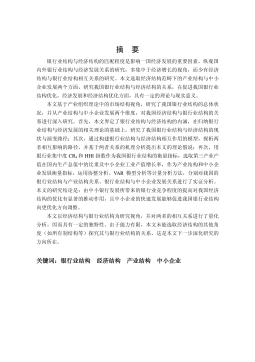
 2025-01-09 7
2025-01-09 7 -
大数据视角下农业供应链金融研究VIP免费

 2025-01-09 6
2025-01-09 6 -
跨国大型综合超市的规划研究VIP免费
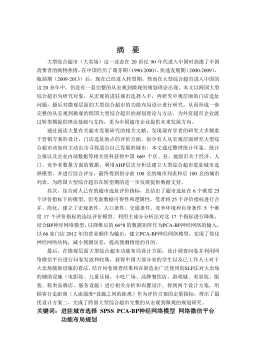
 2025-01-09 6
2025-01-09 6 -
跨境电商农产品质量安全问题研究VIP免费
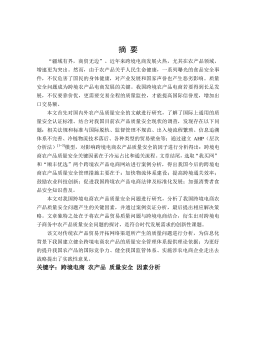
 2025-01-09 7
2025-01-09 7 -
世界市场的虚拟化与我国国际电子商务发展方向研究VIP免费
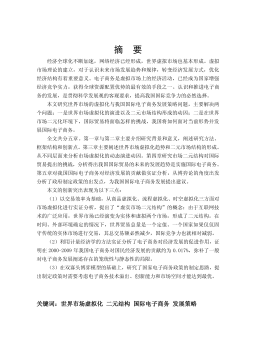
 2025-01-09 9
2025-01-09 9 -
中国政府对电力行业的价格规制问题研究VIP免费
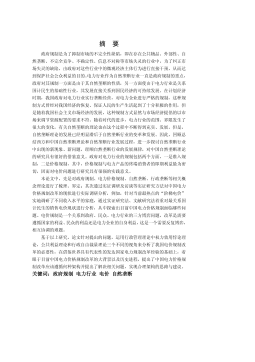
 2025-01-09 14
2025-01-09 14 -
中小企业信息化系统集成技术研究VIP免费
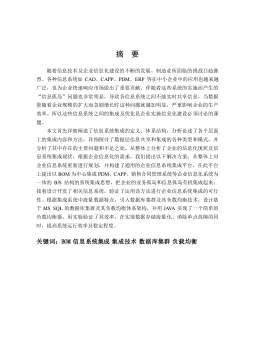
 2025-01-09 14
2025-01-09 14
作者:牛悦
分类:高等教育资料
价格:15积分
属性:103 页
大小:4.53MB
格式:PDF
时间:2025-01-09
相关内容
-

跨国大型综合超市的规划研究
分类:高等教育资料
时间:2025-01-09
标签:无
格式:PDF
价格:15 积分
-

跨境电商农产品质量安全问题研究
分类:高等教育资料
时间:2025-01-09
标签:无
格式:PDF
价格:15 积分
-

世界市场的虚拟化与我国国际电子商务发展方向研究
分类:高等教育资料
时间:2025-01-09
标签:无
格式:PDF
价格:15 积分
-

中国政府对电力行业的价格规制问题研究
分类:高等教育资料
时间:2025-01-09
标签:无
格式:PDF
价格:15 积分
-

中小企业信息化系统集成技术研究
分类:高等教育资料
时间:2025-01-09
标签:无
格式:PDF
价格:15 积分


